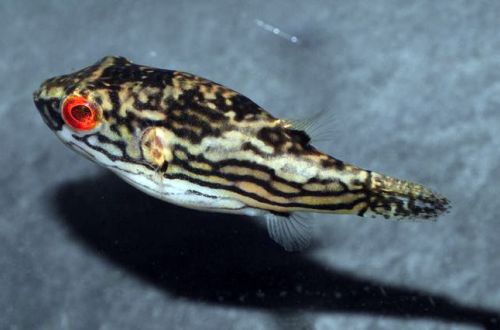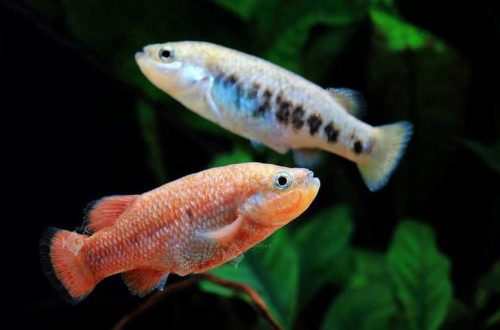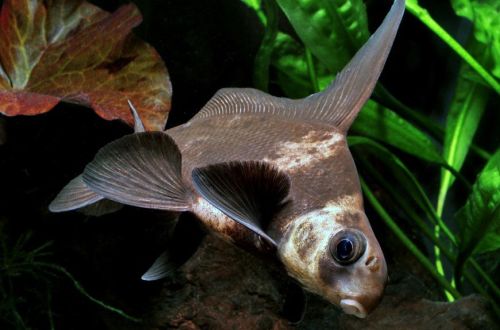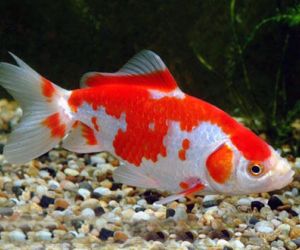
Red-eyed tetradon
The red-eyed tetradon (pufferfish), scientific name Carinotetraodon salivator, belongs to the Tetraodontidae family. Like other members of the family, the fish can swell greatly in case of danger, and to become even more unsightly for a predator, it sticks out sharp needles. It is easy to keep and can be recommended for beginner aquarists.

Contents
Habitat
It comes from Southeast Asia from the Indonesian part of the island of Borneo (Sarawak). It lives in small streams and rivers, prefers running water. The natural habitat is characterized by an abundance of aquatic vegetation, soft sandy substrates, littered with fallen leaves and multi-membered snags.
Brief information:
- The volume of the aquarium – from 50 liters.
- Water and air temperature – 20-28°C
- Value pH — 5.0–7.5
- Water hardness – soft (1-12 dGH)
- Substrate type – sandy
- Lighting – subdued
- Brackish water – no
- Water movement – moderate
- The size of the fish is 4–5 cm.
- Nutrition – meat feed
- Temperament – conditionally peaceful
- Keeping alone in company with other fish
Description
Adults reach a length of up to 5 cm. The fish look somewhat awkward due to their oval shape and small fins. The body is covered with tough skin studded with small needles. The mouth is a beak of two plates of “teeth” and is intended for gnawing shells of mollusks. “Teeth” are subject to grinding, so they grow all their lives. A distinctive feature of the species are red eyes.
The coloring combines a pattern of dark patterns on a gray background, sometimes yellow. In males, the abdomen is reddish, and on the lower part of the head there are 3-5 cream-colored stripes. Females, in turn, have a similar pattern, only the stripes are black, and the abdomen is white.
Food
A carnivorous species, in nature they feed on snails, mussels, shrimps, and scrape algae from the surface of stones. In a home aquarium, solid food should be used, the same mollusks with shells in a live, frozen or ground form. The absence of solid components can lead to excessive increase in “teeth” and subsequent problems with eating. Softer foods such as bloodworms, brine shrimp, dry food (flakes, granules) can diversify the diet.
Maintenance and care, arrangement of the aquarium
The optimal size of the aquarium for one fish starts from 50 liters. The design uses a sandy substrate, clusters of rooting and floating plants, driftwood and other decorative elements, including decorative ones. Adding dried leaves, such as Indian almond or European oak, will not give a natural appearance, but will also positively affect the composition of the water. In the process of decomposition, the leaves will saturate the water with tannins and give it a brownish tea shade. Similar processes occur in nature when leaves, fruits, branches and other vegetation fall into rivers.
Living in flowing waters implies the need to provide high quality water. A productive filtration system along with a weekly replacement of part of the water with fresh water are a must. Regular siphoning will prevent the accumulation of organic waste.
Behavior and Compatibility
It is considered less aggressive in comparison with other tetradons, however, single maintenance is recommended. In large aquariums, it is quite possible to keep several Red-Eyed Pufferfish together, provided that each has enough space of its own. The company can be made up of peaceful fish of a comparable size from among the cyprinids.
Breeding / breeding
Successful experiments in breeding this species in aquariums have not been recorded. Supplied mainly from commercial fish farms in Asia. It is known that in nature, fish lay eggs among thickets of plants. After spawning, the female leaves the clutch, while the male remains to guard it until the fry appear.
Fish diseases
Under the right conditions, disease outbreaks are very rare. The main problem can be “teeth”, which can grow a lot due to the lack of solid food. And this is already fraught with many difficulties. Otherwise, it is a hardy and unpretentious fish.





